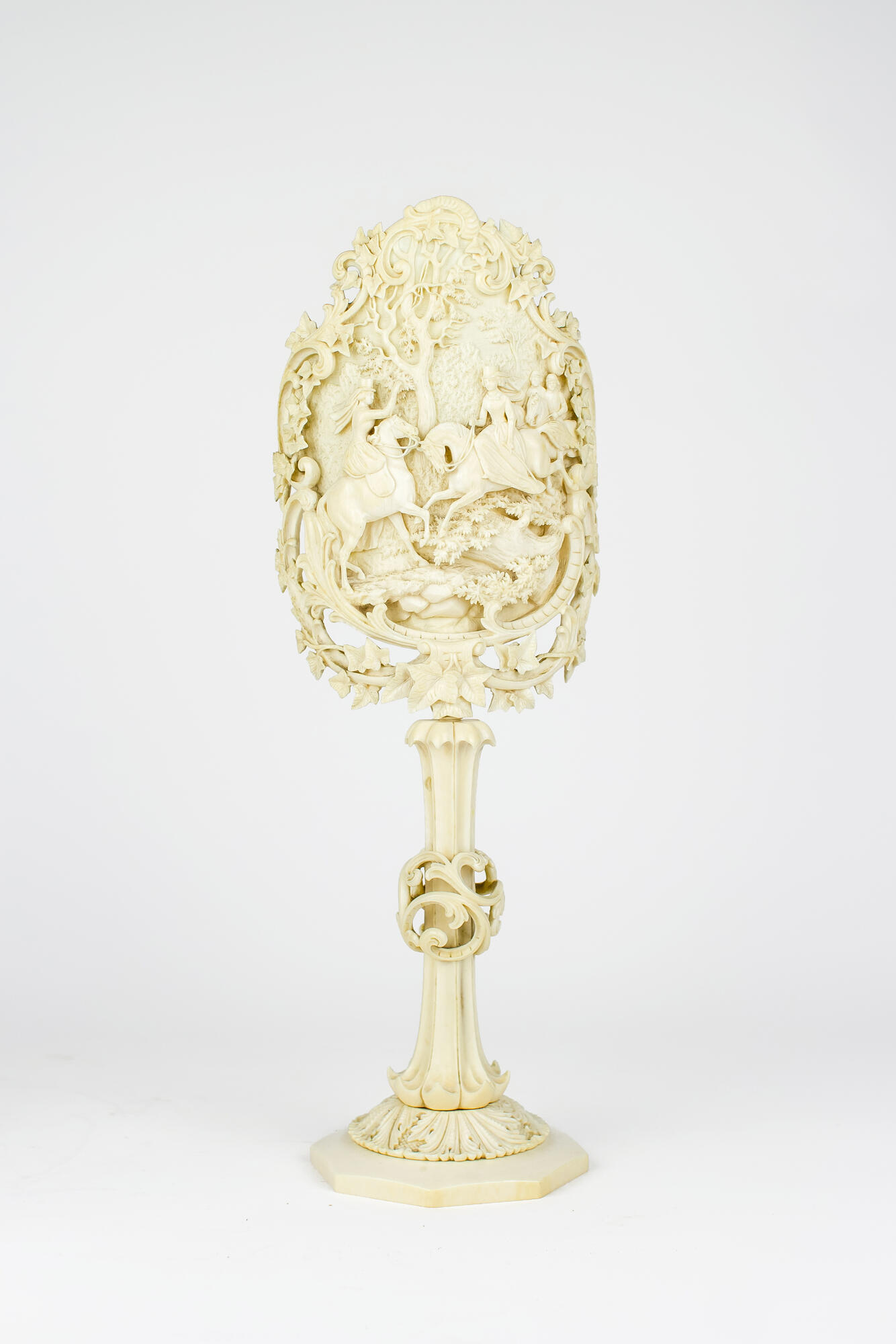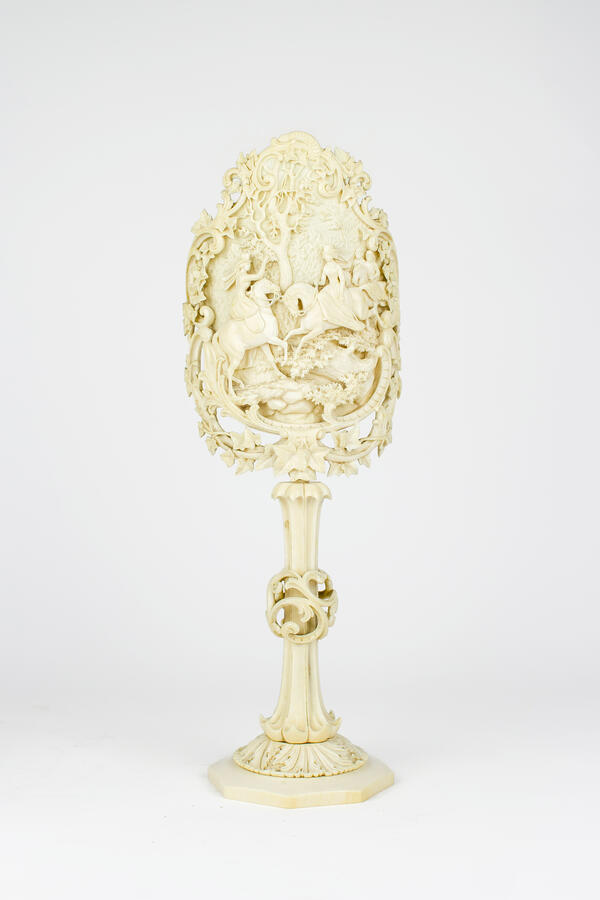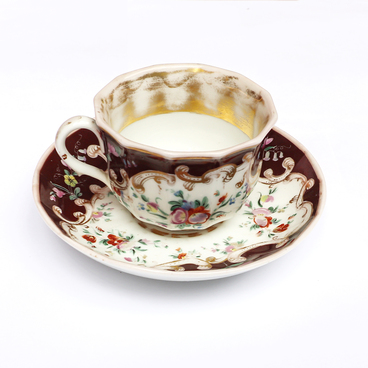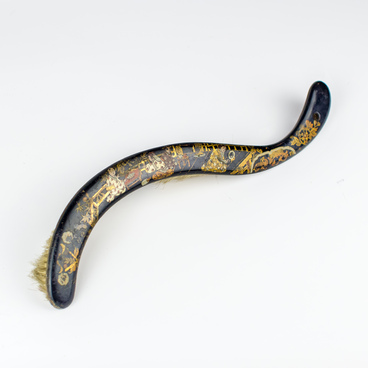A carved curved oval screen for a candle was used for the protection of furniture against flame. Its height was adjustable depending on the candle length. The ivory screen in the exhibition features carvings of four horsemen, as well as plant motifs such as leaves and trees.
The art of bone carving is one of the oldest forms of artistic expression. The bone is easily worked and is good for carving subminiature details on it. Medieval artisans used Indian and African elephant’s ivories, walrus and narwhal tusks, as well as fossil mammoth’s ivory. For cheaper pieces, big domestic animals' shinbones were used.
The art of bone carving in Russia flourished between 12th and 18th centuries. It was then that the main artistic schools of Russian carving were formed. The Kholmogory village in the Arkhangelsk Oblast, the birthplace of the scientist Mikhail Lomonosov, became the center of this art.
The main feature of the Kholmogory carving was an openwork continuous pattern, serving as a background for relief figures and portraits. The Kholmogory ornament major piece was the so-called rocaille scroll, a motif featuring a new-blown fern sprout. Another notable technique of the Kholmogory masters was openwork carving which made the handicraft look like lace.
In the 17th century, with the arrival of Russian settlers and Swedish prisoners exiled to Siberia after the Battle of Poltava, bone carving began to develop around the city of Tobolsk. The local artisans encrusted white bone items with other natural shade bones.
Another ancient school of carving, the Chukchi school, dates back to the first millennium AD. Sea-hunting industry was the ancestral one of the Chukchi and Eskimos, inhabiting the Bering Gulf the coast. The walrus was the best trophy, and its tusks were the basic material both the hunting gear, and small sculptures and figurines. The Chukchi art of bone carving became popular in the 18th-19th centuries.
The local artisans carved from walrus tusk the figures of animals, predominantly dogs and bears. In addition to sculptural carving, the peoples of Chukotka were engaged in bone engraving. The scenes from the Chukchi people’s life, legend and narrative plots, dramatic moments of hunting and fishing were depicted on the polished surface of the walrus tusk sides. Sometimes black and red paints were rubbed into the lines.
The art of bone carving is one of the oldest forms of artistic expression. The bone is easily worked and is good for carving subminiature details on it. Medieval artisans used Indian and African elephant’s ivories, walrus and narwhal tusks, as well as fossil mammoth’s ivory. For cheaper pieces, big domestic animals' shinbones were used.
The art of bone carving in Russia flourished between 12th and 18th centuries. It was then that the main artistic schools of Russian carving were formed. The Kholmogory village in the Arkhangelsk Oblast, the birthplace of the scientist Mikhail Lomonosov, became the center of this art.
The main feature of the Kholmogory carving was an openwork continuous pattern, serving as a background for relief figures and portraits. The Kholmogory ornament major piece was the so-called rocaille scroll, a motif featuring a new-blown fern sprout. Another notable technique of the Kholmogory masters was openwork carving which made the handicraft look like lace.
In the 17th century, with the arrival of Russian settlers and Swedish prisoners exiled to Siberia after the Battle of Poltava, bone carving began to develop around the city of Tobolsk. The local artisans encrusted white bone items with other natural shade bones.
Another ancient school of carving, the Chukchi school, dates back to the first millennium AD. Sea-hunting industry was the ancestral one of the Chukchi and Eskimos, inhabiting the Bering Gulf the coast. The walrus was the best trophy, and its tusks were the basic material both the hunting gear, and small sculptures and figurines. The Chukchi art of bone carving became popular in the 18th-19th centuries.
The local artisans carved from walrus tusk the figures of animals, predominantly dogs and bears. In addition to sculptural carving, the peoples of Chukotka were engaged in bone engraving. The scenes from the Chukchi people’s life, legend and narrative plots, dramatic moments of hunting and fishing were depicted on the polished surface of the walrus tusk sides. Sometimes black and red paints were rubbed into the lines.



